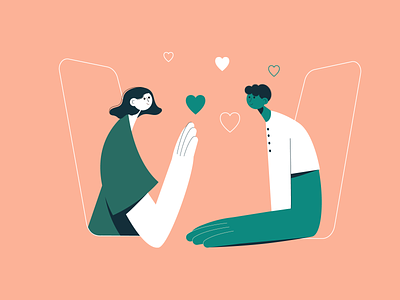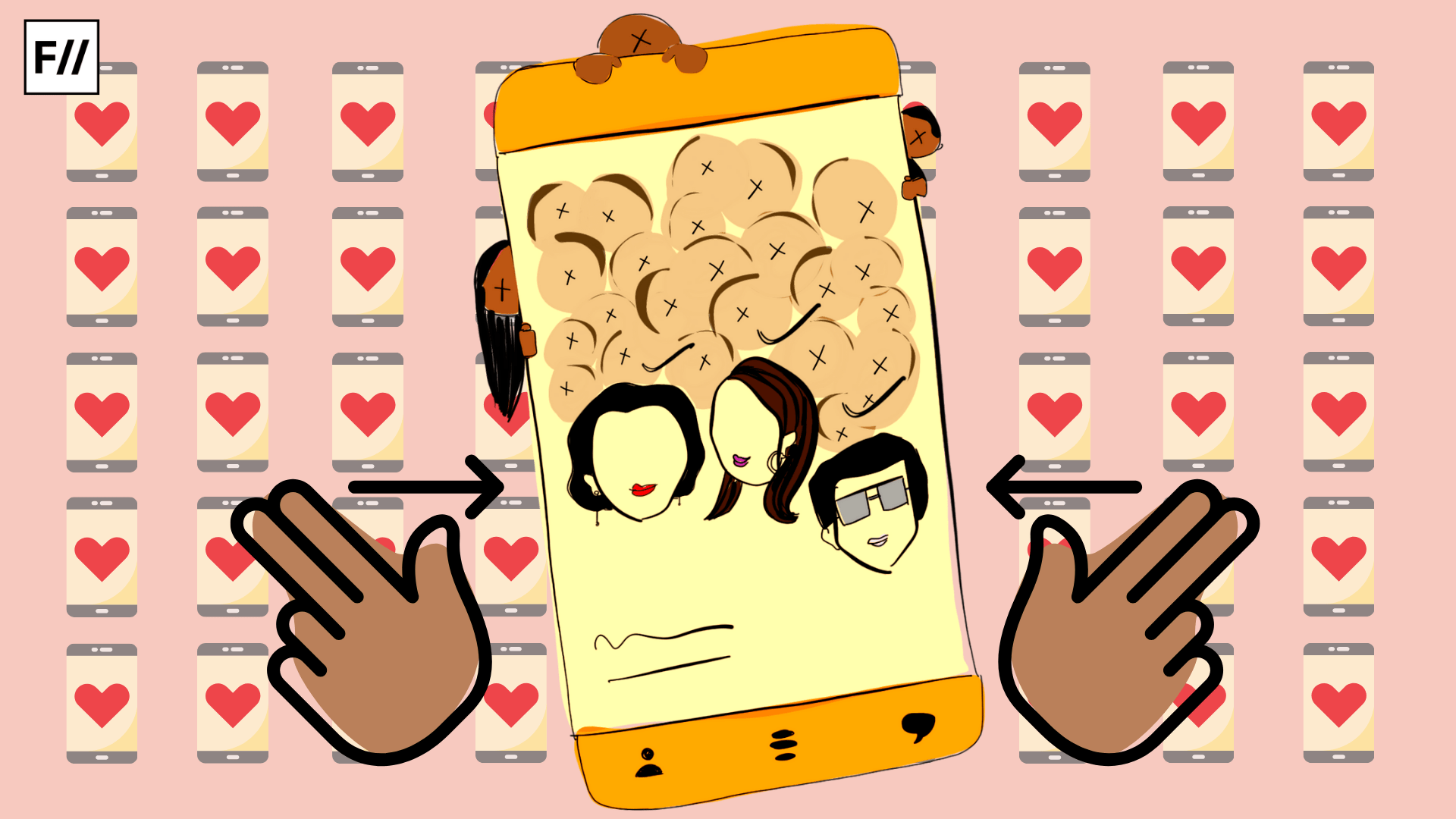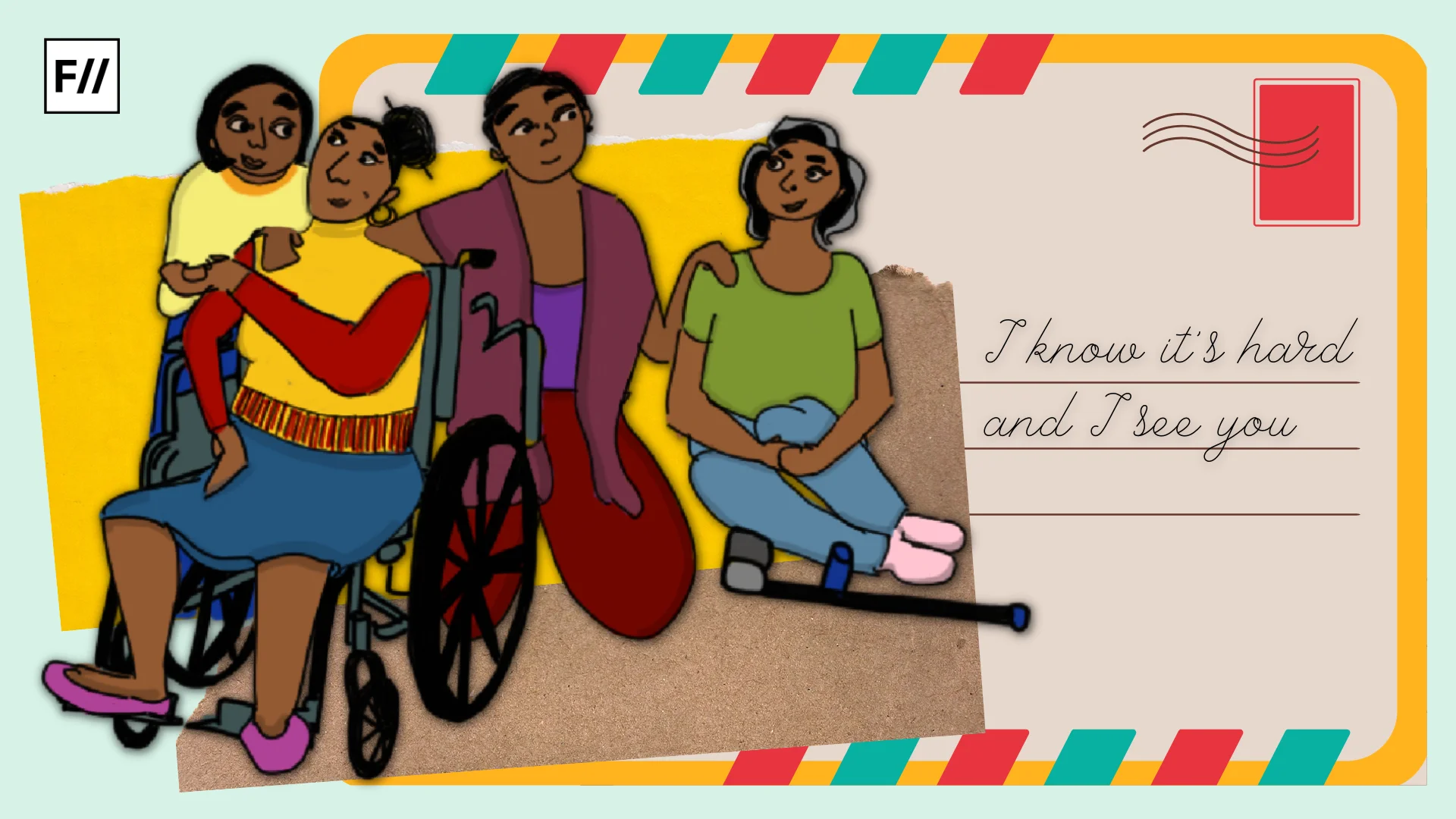Editor’s Note: FII’s #MoodOfTheMonth for August, 2021 is Digital Realities. We invite submissions on the many layers of experiences from the virtual world throughout the month. If you’d like to contribute, kindly email your articles to sukanya@feminisminindia.com
No matter how overdone and over said it might seem, it is true that one of our worst nightmares in recent years has been the quarantine. The physical isolation has made our social selves turn into lonely hobbits craving for some companionship to keep us afloat in the sea of heartbreaking news.
People found solace in different virtual media to stay in touch with the outside world and one of the most popular and easy options is dating apps.

The concept of dating apps, contrary to popular belief, is not very new in India. There has just been a shift from shaadi apps, used by millennials, to apps like Tinder and Bumble. The underlying quest for an ego boost and catering to our psychological needs of getting validated and appreciated, remain the same.
But, some swords are surely double-edged. The innocuous ways in which a particular clique derives its momentary happiness also sometimes snatches these very feelings from another section of people.
An unfortunate few fail to fulfil certain ‘invisible criteria‘, preventing them from flourishing in the dating world. But have we ever asked ourselves what these criteria are? Who are the Big-Bs getting the preferential treatment? Is it the typically privileged, fair skinned, slim and heterosexual individual who is preferred over the so called “others”?
It won’t be entirely wrong to say that many of us interacted with the wider outside world for the first time through dating apps, during this pandemic. The world without the filter of our homes, colleges and parents would seem especially harsh if not for the occasional confidence boost from a potential romantic partner.

An unfortunate few fail to fulfil certain ‘invisible criteria‘, preventing them from flourishing in the dating world. But have we ever asked ourselves what these criteria are? Who are the Big-Bs getting the preferential treatment? Is it the typically privileged, fair skinned, slim and heterosexual individual who is preferred over the so called “others”?
Also read: Do Gender Non-Conforming People Have A Place In Dating Apps?
Popular media and movies have been feeding us the definition of “dateable” individual through songs, movies and advertisements for decades. Be it movies like Super30, where a light skinned man was mysteriously made dark skinned or Mary Kom, which casted a mainstream actress in the biopic of a person from the minority community, for argument’s sake, even if we say that casting is rocket science and the audience would not get the practical nuances involved in it, we would still be left with a plethora of advertisements like “FairNLovely”. All these forms of visual media plant the idea of what an ideal partner should be like, in our subconscious.
The age-old problem of India’s racism has been called out numerous times. But has that been enough? Yes, the ordeal of dark skinned girls and fairness creams has been spoken time and again of. But we won’t do justice if we don’t speak about the young boys who have been victims of the same, maybe not as much as their women counterparts, but victims nonetheless.
We fail to ask ourselves where our obsession stems from. Why do we, living in a geographical area where our racial evolution and climatic conditions result in higher melanin of the skin, incessantly try to look like our colonisers?
Despite the health and environmental hazards related of skin bleaching and brightening products, we continue to use them. Since lighter skin has been seen as the marker of a better standard of living and a higher socio-economic status, our ingrained elitism has led to the othering of the darker skinned members on dating apps
Interviewing 20 members of the queer community, we wanted to get a semblance of the criteria they consider while on a swiping spree. One common answer was the authenticity of the profile. While things like hairstyle, piercings, aesthetics and the quality of the picture made it to the list, nobody talked about the complexion of their right-swipes in contrast to 7 out of 15 cis-het people who did.
Even though this cannot be generalised and applied to all heterosexual people, it compels us to talk about the socialisation that desi people are put through from a young age, that turns them into milky-white-skin worshipers.

Despite the health and environmental hazards related of skin bleaching and brightening products, we continue to use them. Since lighter skin has been seen as the marker of a better standard of living and a higher socio-economic status, our ingrained elitism has led to the othering of the darker skinned members on dating apps.
No matter how much we preach equality on our Instagram pages, our bias towards the elites and upper classes of the society stares back at us when we right swipe to fill our beehives.
Numerous unanswered questions come out of the veil of progressiveness when we start questioning the socialisation of young people. Relationships have been commodified deliberately by big companies like Bumble to profit. Elitism and racism are direct consequences of the post colonial hangover, patriarchy and a highly misogynistic society
Diving into the sociology of Bumble, it can be seen that the algorithm favours not only the upper class but also the upper castes. Interviewing upper caste users on the platform, we got to know that the app seldom shows any Dalits on their list. Centuries of fighting casteism and classism fails when grave issues are shrugged off casually by these companies.
But the app only shows us what we like to see, right? How often do we find ourselves not right-swiping someone with a starbucks coffee cup or an i-phone in their hand?

Numerous unanswered questions come out of the veil of progressiveness when we start questioning the socialisation of young people. Relationships have been commodified deliberately by big companies like Bumble to profit. Elitism and racism are direct consequences of the post colonial hangover, patriarchy and a highly misogynistic society.
This has resulted in oppressing men and women alike by instilling in them a hate for the darker skin. Owing to our patriarchal society, women have been falling prey to racism more than men, while men have been conditioned to stay under the carpet of unrealistic societal parameters.
Also read: NotOK, Cupid! Misogyny in Online Dating
While it is easy to follow “Black Lives Matter” and “Dalit Lives Matter” on social media, we are yet to surpass the basic discrimination towards people who have been systemically oppressed throughout history. The Big-B or the preferred circle of people on dating apps is the product of unquestioned social hierarchies.
Once we start identifying the diverse, dynamic identities of scores of people in and around our lives, dating apps and their algorithms will follow.
Aditi Narayani is an assistant sociology professor at Maitreyi College, University of Delhi. You may find her on Instagram, LinkedIN and Facebook.
Debarati Mitra is a first year sociology honours student at Maitreyi College, University of Delhi. You many find her on Instagram and Facebook.
Sanjana Sinha is a first year sociology honours student at Maitreyi College, University of Delhi. You may find her on Instagram, LinkedIN and Facebook
Featured Image: Ritika Banerjee for Feminism In India




